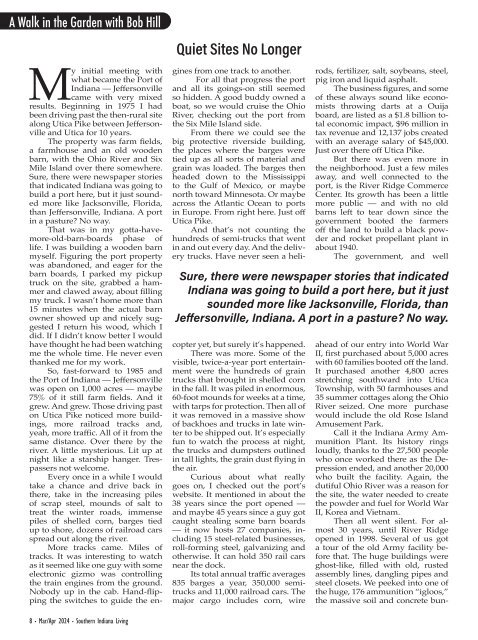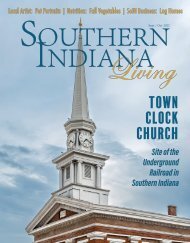Southern Indiana Living - March / April 2024
The March/April 2024 issue of Southern Indiana Living
The March/April 2024 issue of Southern Indiana Living
You also want an ePaper? Increase the reach of your titles
YUMPU automatically turns print PDFs into web optimized ePapers that Google loves.
A Walk in the Garden with Bob Hill<br />
Quiet Sites No Longer<br />
My initial meeting with<br />
what became the Port of<br />
<strong>Indiana</strong> — Jeffersonville<br />
came with very mixed<br />
results. Beginning in 1975 I had<br />
been driving past the then-rural site<br />
along Utica Pike between Jeffersonville<br />
and Utica for 10 years.<br />
The property was farm fields,<br />
a farmhouse and an old wooden<br />
barn, with the Ohio River and Six<br />
Mile Island over there somewhere.<br />
Sure, there were newspaper stories<br />
that indicated <strong>Indiana</strong> was going to<br />
build a port here, but it just sounded<br />
more like Jacksonville, Florida,<br />
than Jeffersonville, <strong>Indiana</strong>. A port<br />
in a pasture? No way.<br />
That was in my gotta-havemore-old-barn-boards<br />
phase of<br />
life. I was building a wooden barn<br />
myself. Figuring the port property<br />
was abandoned, and eager for the<br />
barn boards, I parked my pickup<br />
truck on the site, grabbed a hammer<br />
and clawed away, about filling<br />
my truck. I wasn’t home more than<br />
15 minutes when the actual barn<br />
owner showed up and nicely suggested<br />
I return his wood, which I<br />
did. If I didn’t know better I would<br />
have thought he had been watching<br />
me the whole time. He never even<br />
thanked me for my work.<br />
So, fast-forward to 1985 and<br />
the Port of <strong>Indiana</strong> — Jeffersonville<br />
was open on 1,000 acres — maybe<br />
75% of it still farm fields. And it<br />
grew. And grew. Those driving past<br />
on Utica Pike noticed more buildings,<br />
more railroad tracks and,<br />
yeah, more traffic. All of it from the<br />
same distance. Over there by the<br />
river. A little mysterious. Lit up at<br />
night like a starship hanger. Trespassers<br />
not welcome.<br />
Every once in a while I would<br />
take a chance and drive back in<br />
there, take in the increasing piles<br />
of scrap steel, mounds of salt to<br />
treat the winter roads, immense<br />
piles of shelled corn, barges tied<br />
up to shore, dozens of railroad cars<br />
spread out along the river.<br />
More tracks came. Miles of<br />
tracks. It was interesting to watch<br />
as it seemed like one guy with some<br />
electronic gizmo was controlling<br />
the train engines from the ground.<br />
Nobody up in the cab. Hand-flipping<br />
the switches to guide the engines<br />
from one track to another.<br />
For all that progress the port<br />
and all its goings-on still seemed<br />
so hidden. A good buddy owned a<br />
boat, so we would cruise the Ohio<br />
River, checking out the port from<br />
the Six Mile Island side.<br />
From there we could see the<br />
big protective riverside building,<br />
the places where the barges were<br />
tied up as all sorts of material and<br />
grain was loaded. The barges then<br />
headed down to the Mississippi<br />
to the Gulf of Mexico, or maybe<br />
north toward Minnesota. Or maybe<br />
across the Atlantic Ocean to ports<br />
in Europe. From right here. Just off<br />
Utica Pike.<br />
And that’s not counting the<br />
hundreds of semi-trucks that went<br />
in and out every day. And the delivery<br />
trucks. Have never seen a helicopter<br />
yet, but surely it’s happened.<br />
There was more. Some of the<br />
visible, twice-a-year port entertainment<br />
were the hundreds of grain<br />
trucks that brought in shelled corn<br />
in the fall. It was piled in enormous,<br />
60-foot mounds for weeks at a time,<br />
with tarps for protection. Then all of<br />
it was removed in a massive show<br />
of backhoes and trucks in late winter<br />
to be shipped out. It’s especially<br />
fun to watch the process at night,<br />
the trucks and dumpsters outlined<br />
in tall lights, the grain dust flying in<br />
the air.<br />
Curious about what really<br />
goes on, I checked out the port’s<br />
website. It mentioned in about the<br />
38 years since the port opened —<br />
and maybe 45 years since a guy got<br />
caught stealing some barn boards<br />
— it now hosts 27 companies, including<br />
15 steel-related businesses,<br />
roll-forming steel, galvanizing and<br />
otherwise. It can hold 350 rail cars<br />
near the dock.<br />
Its total annual traffic averages<br />
835 barges a year, 350,000 semitrucks<br />
and 11,000 railroad cars. The<br />
major cargo includes corn, wire<br />
rods, fertilizer, salt, soybeans, steel,<br />
pig iron and liquid asphalt.<br />
The business figures, and some<br />
of these always sound like economists<br />
throwing darts at a Ouija<br />
board, are listed as a $1.8 billion total<br />
economic impact, $96 million in<br />
tax revenue and 12,137 jobs created<br />
with an average salary of $45,000.<br />
Just over there off Utica Pike.<br />
But there was even more in<br />
the neighborhood. Just a few miles<br />
away, and well connected to the<br />
port, is the River Ridge Commerce<br />
Center. Its growth has been a little<br />
more public — and with no old<br />
barns left to tear down since the<br />
government booted the farmers<br />
off the land to build a black powder<br />
and rocket propellant plant in<br />
about 1940.<br />
The government, and well<br />
Sure, there were newspaper stories that indicated<br />
<strong>Indiana</strong> was going to build a port here, but it just<br />
sounded more like Jacksonville, Florida, than<br />
Jeffersonville, <strong>Indiana</strong>. A port in a pasture? No way.<br />
ahead of our entry into World War<br />
II, first purchased about 5,000 acres<br />
with 60 families booted off the land.<br />
It purchased another 4,800 acres<br />
stretching southward into Utica<br />
Township, with 50 farmhouses and<br />
35 summer cottages along the Ohio<br />
River seized. One more purchase<br />
would include the old Rose Island<br />
Amusement Park.<br />
Call it the <strong>Indiana</strong> Army Ammunition<br />
Plant. Its history rings<br />
loudly, thanks to the 27,500 people<br />
who once worked there as the Depression<br />
ended, and another 20,000<br />
who built the facility. Again, the<br />
dutiful Ohio River was a reason for<br />
the site, the water needed to create<br />
the powder and fuel for World War<br />
II, Korea and Vietnam.<br />
Then all went silent. For almost<br />
30 years, until River Ridge<br />
opened in 1998. Several of us got<br />
a tour of the old Army facility before<br />
that. The huge buildings were<br />
ghost-like, filled with old, rusted<br />
assembly lines, dangling pipes and<br />
steel closets. We peeked into one of<br />
the huge, 176 ammunition “igloos,”<br />
the massive soil and concrete bun-<br />
8 • Mar/Apr <strong>2024</strong> • <strong>Southern</strong> <strong>Indiana</strong> <strong>Living</strong>
















